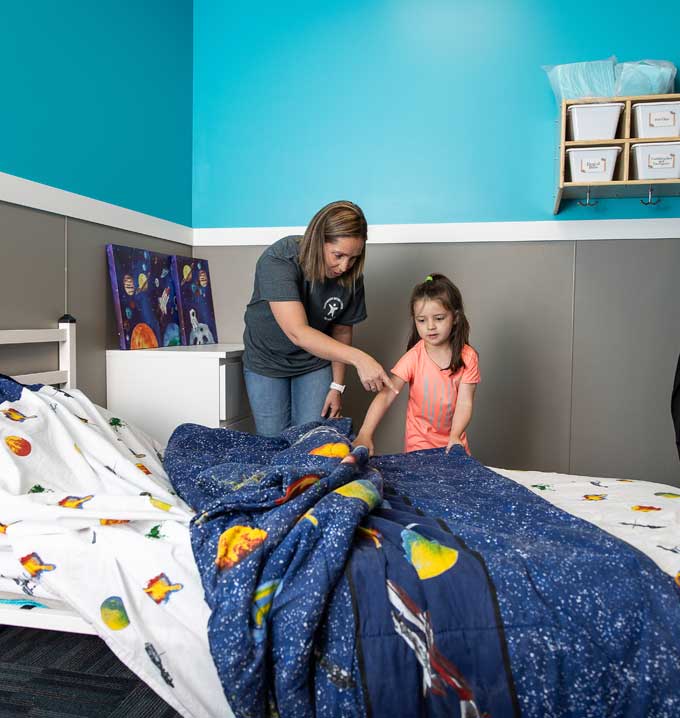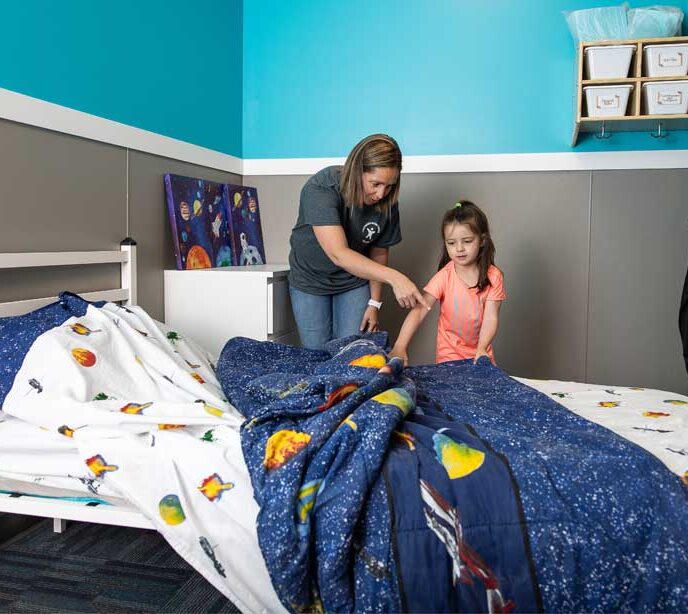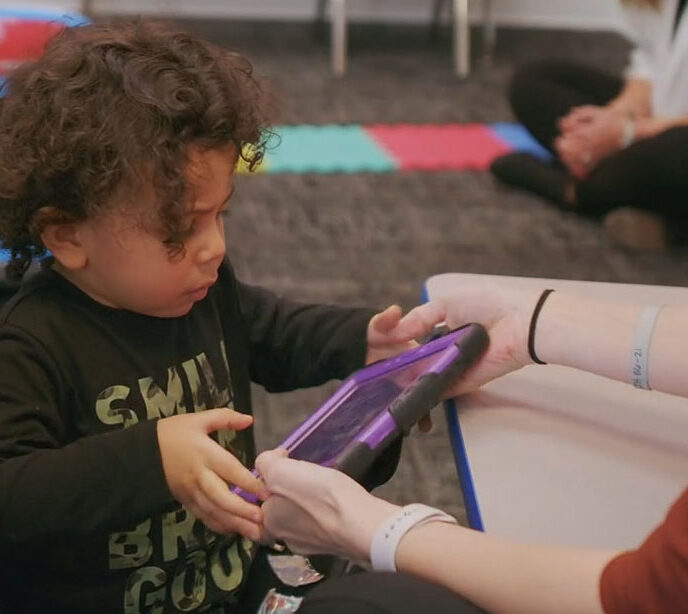Simple Autism Routine
The simpler, the better when it comes to developing a routine for your autistic child. Predictable routines provide a sense of comfort and stability that can be extremely beneficial for autistic children. Discover the benefits of simple routines, how to create them, and ways to handle changes.

Building Simple Daily Routines That Help Autistic Children Thrive
Many parents and caregivers ask themselves, “Is routine good for autism”? The short answer is yes. The longer answer is that all children benefit from structure, but autism and routines are notably more connected. Predictable schedules give autistic children a sense of safety, reduce anxiety, and make the day feel more understandable and easy to navigate.
A routine isn’t strictly about rules or rigidity either. Instead, it’s about creating a predictable rhythm that makes the day-to-day feel more manageable. When children know what to expect, they often feel more confident and ready to take on new experiences. This blog will explore the importance of routine for autism, how simple schedules support growth, and what parents can do when disruptions happen.
Routine Changes and Autism: The Importance of Routine for Autism
Life with young children often feels busy and unpredictable. But when it comes to routine disruption and changes for autistic children, that unpredictability can be especially overwhelming. A consistent daily routine can make everyday life feel a lot calmer, more manageable, and more enjoyable for both children and their families.
Routines help everyone every day. Predictable schedules and planned routines allow us to stay organized and complete essential tasks. For children, daily routines are also useful for reducing stress, providing structure, and creating opportunities to learn new skills in familiar ways. At Lighthouse Autism Center (LAC), we’ve seen how routines bring comfort and help children feel secure while encouraging independence.
Establishing solid, simple routines at home and at school can bring relief for parents, caregivers, and children. They provide comfort, promote learning, and build confidence that daily life is something children can navigate successfully.
Autism and Routine: How Simple Schedules Bring Calm and Confidence?
Do autistic people like routine? For most, the answer is yes. Routines bring a level of comfort and stability to everyday activities that otherwise could be very overwhelming. Consistency, repetition, and predictability are valuable tools for an autistic child. Repetitive patterns reinforce positive behaviors and important life skills.
Understanding habit vs. routine in autism is also helpful. Habits are automatic actions, while routines are intentional and structured. For autistic children, routines create the framework for building positive habits that support independence.
For example, brushing teeth might start as a structured part of the bedtime routine. Over time, with consistency and practice, it can become a habit that your child completes on their own without reminders. This progression from routine to habit shows how daily structure supports long-term growth.
Here are some of the most meaningful benefits of developing a simple schedule for your child:
Reduces Stress
Predictability can take away a lot of uncertainty. For autistic children, knowing what comes nest makes the day feel less overwhelming. Routines help children understand their surroundings and expectations, which lowers anxiety and builds confidence as they see themselves completing tasks successfully.
Assists With Transitions
Change can be exciting for some children but stressful for others. Many autistic children simply don’t like change and find periods of transition especially challenging, whether it’s starting school, moving to a new home, trying new foods, or even shifting from playtime to bedtime. A routine offers stability that helps them prepare for and adjust to new environments and expectations.
Nurtures a Learning Environment
Learning daily living skills often takes more repetition and practice for autistic children than it does for allistic children. A consistent schedule provides those repeated opportunities, making it easier for your child to remember, get used to, and master new skills. Over time, this structure creates a strong foundation for independence.
Gives Children a Sense of Ownership Over Their Day
It’s frustrating when you can’t explain what you want or achieve something that you’ve set out to do, and autistic children experience this daily. Establishing a routine helps to give them a sense of ownership over their day, especially when they get to a level of independence where they can take on some tasks on their own or make their own schedule.
Builds Stronger Connections
Autistic children can struggle to connect with their parents, teachers, caregivers, and friends, but predictability creates room for social interaction and bonding. So, as their sense of purpose, fulfillment, predictability, and security increases, their stress and anxiety tend to decrease. This can make them more receptive and improve their self-confidence, making them better able to connect with others.
Creating a Schedule for Your Child
The best routine is one that is simple, consistent, and easy to follow. Overly complicated schedules can create frustration rather than comfort. Here are some steps for creating an effective daily routine:
Identify the Most Important Tasks in Their Daily Routine
A successful schedule is a simple one. Outline the tasks that you classify as the most important for your child to complete during the day and write them down. Start with just a few at the beginning, and you can always add more once they’ve mastered it.
One of the common challenges of autism is difficulty following instructions, so ensure that all of the steps are predictable and specific.
First, give the task a name, and then break that into smaller, more manageable instructions for your child. For example, the bigger task could be “Get ready for bed”, and you can break it down into smaller steps such as:
- Get into pajamas
- Brush teeth
- Listen to one bedtime story
- Turn off the light
Be patient and figure out what format works best for your child.
Assign Times and Alerts
To ensure that the routine is predictable and on schedule, it’s important to assign every activity a time and preferably an alert that will remind you and your child. Alerts can help to diminish the monotony of a schedule. You can use fun alerts, such as animal noises, on your phone and assign a different alert to each task. This gives your child the chance to recognize what the alert is signifying and either tell you what needs to be done or attempt the task on their own if they are ready and capable.
Make it Visual
Don’t expect your child to remember what they are going to do at the end of the day. Instead, refer to the calendar throughout the day and remind your child of what is going to happen next. For example, remind them while they are crafting that they are expected to clean up their craft materials once they are done.
Refer to the Schedule Throughout the Day
Don’t expect your child to remember what they are going to do at the end of the day. Instead, refer to the calendar throughout the day and remind your child of what is going to happen next. For example, remind them while they are crafting that they are expected to clean up their craft materials once they are done.
Use Positive Reinforcement
Everyone could use a bit of positive reinforcement, and you should let your child know how well they are doing when they get a task done successfully. Of course, how you do this depends on your child’s individual nature, but putting gold stars next to a task on your visual schedule or something similar is a great idea. Do whatever it is to let them understand that you are proud of them.
Patience and Persistence
The first couple of days with a new schedule can be challenging for both of you. Consistency is key in the beginning, and you need to ensure that you tick off all the steps in order. Repeat the routine in the same way every day and remain patient. Once your child starts to get the hang of it, all your hard work will be worth it.
Once the routine is firmly established, you can start to alter things a little bit at a time. Try to involve another family member or caregiver in the routine, or slowly introduce an additional step if you would like. As much as a consistent routine is important, it’s also a good idea to get them used to change and transition while they are comfortable, as this will be a valuable tool for the future.
Learn about Routines, Schedules, Handling Change, and More with LAC
Lighthouse Fusion ABA Therapy is an innovative approach that combines the best ABA therapy practices with speech therapy to create a unique model that delivers exceptional outcomes for autistic children. With our decades of experience in the industry and a wide array of autism resources that are available to you, we aim to equip you and your child with the right tools to tackle everyday activities that will set them up for a better future. Contact us to learn more about how we can help.
Together, we can unlock your child’s potential
Related News

10/22/2025
Simple Autism Routine
The simpler, the better when it comes to developing a routine for your autistic child. Predictable routines provide a sense of comfort and stability that can be extremely beneficial for autistic children. Discover the benefits of simple routines, how to create them, and ways to handle changes. Building Simple Daily Routines That Help Autistic Children […]

10/22/2025
Traveling with an Autistic Child
Preparing for a Trip with Autistic Children When you’re making any travel plans, preparation is key. The small bit of extra planning can make a huge difference in ensuring everything runs more smoothly. But, when you’re traveling with an autistic child, there are additional factors that can make travel more challenging, from finding autism-friendly vacation […]

10/07/2025
PECS and Its Use in ABA Therapy – Lighthouse Autism Center
The picture exchange communication system, or PECS, is a teaching system that can help an autistic child or another individual with speech difficulties improve their communication skills. We take a look at PECS’ role in ABA therapy and unpack how it works. What Is the PECS System and How Is It Used In ABA Therapy? […]


